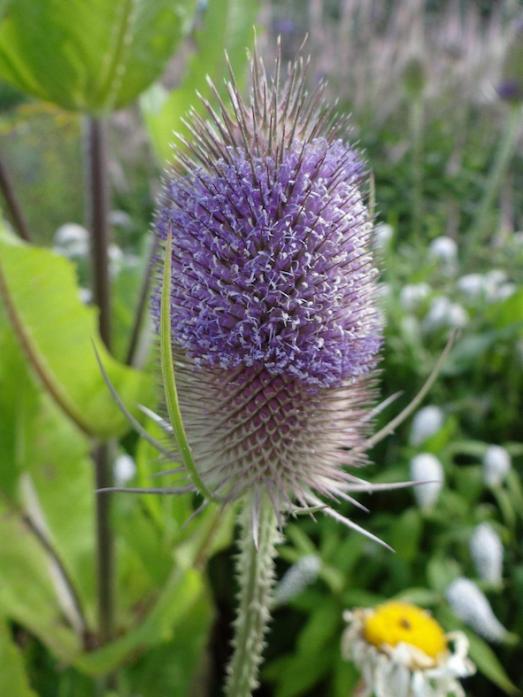
Teasel (Dipsacus sativus) Fuller’s teasel, Brushes-and-combs
TEASEL is a large plant, up to six feet high, and common on waste ground, roadsides and rough pasture, particularly on clay soils.
It is a biennial with prickly leaves in a rosette at the base. (These die early in the second year of growth).
The leaves higher up are swollen where they meet the stem to form water-collecting troughs. These probably prevent insects from climbing up to the flowers and destroying them. The stem itself is squarish and prickly, and underground is a stout yellowish taproot.
The flower head – the teasel – can be seen from July onwards. It is cone-shaped and erect, and bears a ring of rose-purple flowers that appears to move slowly upwards. These attractive flowers are visited by bees and long-tongued flies.
The mature brown teasel head, known as brushes-and-combs, has been used for centuries to tease out wool fibres before spinning, a process known as carding. (In French, the word for teasel is cardère).
These beautifully arranged bristle heads are cut in half, and, placed on racks, formed an early pre-industrial loom.
Naturally, these have since been replaced by metal brushes, but in some fabrics the special elasticity or “give” of the teasel bristles is still used to raise a nap for a fine finish on some hats and, especially, the baize of billiard tables.
There are several kinds of teasel, but the most useful is Fuller’s. (A fuller was a craftsman who cleaned and finished cloth.)
The Greek physician Dioscorides suggests boiling the root in wine until the mixture thickens (like arrowroot), then storing it in a brass vessel or pot and using it as a salve to heal fistulas, and rid the body of warts and weans (sores). The juice of the leaves, dropped in to the ears, supposedly kills worms.
More mundanely, in Raby Castle, the prickly stems and heads have been put on certain chairs to discourage visitors from sitting on them.
Thorngate, in Barnard Castle, has a row of weavers’ cottages with special top floor windows to let more light in as the weavers worked. Curiously, teasels are found growing in some of their back gardens, although it is not known whether these plants are hardy survivors from weaving days or an affectionate nod to the past by the current residents.
Dr Richard Warren is a botanist from Barnard Castle





